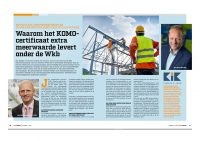Building Quality Assurance Act: why KOMO certificate provides added value!
July 9, 2020
Article Bouwbelang June 2020
As burden of proof for risk management and preferential status of the KOMO certificate holder
The KOMO certificate proves its value, also when it comes to the Building Quality Assurance Act (hereinafter Wkb) and the amended burden of proof that lies with the builder. Products and building processes with the KOMO quality mark prove that the building work is good, reduce the costs of calling in the quality assurance provider (less time) and demonstrate both that the correct products and working methods have been applied. All those involved benefit; the client (reduced costs for a quality assurance provider), the builder (proof) and the certificate holder/subcontractor/supplier (preferential status). In other words, the KOMO certificate helps all operators within the building sector chain. KOMO certified products and processes pay for themselves.

Jaco Uittenbogaard, AFNL
Jaco Uittenbogaard (AFNL director) in Bouwbelang June 2020 (Dutch technical journal): “Building under the Environment and Planning Act and the Wkb demands a different working method. During building until completion an independent quality assurance officer assesses whether the structure meets the legal requirements. This is done with an obligatory quality assurance tool (KiK!) The inspecting officer checks whether the builder really does build according to the Building Decree 2012 and records the inspection results. Along with the amendments to the Wkb and the Environment and Planning Act, the builder’s liability has also been adjusted in the Civil Code. The changes mean that as a contractor, you now have to pay even more attention to what you do and how you build.”
KOMO certificate helps builder manage liability
The amended burden of proof means that the builder is liable for defects, even after delivery. It does not matter whether or not these defects could have been identified on completion. An exception to this is when the defect cannot be attributed to the builder, such as when a design fault is identified. Ultimately, it is the builder who must now provide proof for this (the burden of proof reversed). Who is liable for this, depends on who is to blame for the defect.
“The builder is responsible for the products he/she processes and the processing of these by subcontractors. The application of KOMO certified products and processes provides demonstrable quality on which the builder can rely and build. This gives building companies the assurance they need to manage their liability safely,” says Jaco Uittenbogaard.
Quality assurer guarantees quality with KOMO certificate
The quality assurer conducts an obligatory risk assessment in the run-up to implementation. This risk assessment is majorly important for the assessment of the building plan and will eventually result in the assurance plan, the basis for quality assurance. How pleasant it is, then, that the builder and the quality assurer can rely on certain guarantees during the building process. The quality needs to be clearly defined in black and white. This definitely applies to products and building processes that come with KOMO certification. If the KOMO certificate demonstrates the quality, then fewer or no checks at all need to be performed by the quality assurer at the building site.

Berry Blaak, SKG-IKOB
SKG-IKOB: KOMO certificate tested time and time again
Berry Blaak from the Dutch SKG-IKOB certification body explains: “Everything that is KOMO certified meets the requirements of market parties as well as the government. As an SKG-IKOB certification body, we test the KOMO quality again and again. Whether it concerns a product certificate or process certificate. Through that the market can rely on consistent quality.”
“An internal quality assessment, which is also obligatory within the Wkb framework, is a standard part of the KOMO process certificate. Based on the KOMO process certificate, we conduct random checks on the quality of all building components during the building process. This is an activity that the quality assurer may perhaps no longer need to do.
When it concerns KOMO product certificates, we regularly carry out announced or unannounced inspections at manufacturer locations. Guaranteed quality also applies to this. If the quality assurer anticipates certain risks when assessing the building plan, he/she needs to establish whether or not KOMO certified products or KOMO certified processes have been used. If they have indeed been used, the quality assurer can rely on quality and this saves him/her time and the client money.”
KiK supports KOMO certificates
The Wkb tool called KiK, demonstrably helps to meet all the quality requirements demanded for each building structure. From legislation, private requirements and project-specific requirements.
The quality assurer using the KiK tool can check out the risk analysis to see whether there are related KOMO certificates in the risk analysis. If the answer is yes, then the risk is covered. Summing up: Also under the Wkb, KOMO certificates give manufacturers and builders a crucial advantage!

